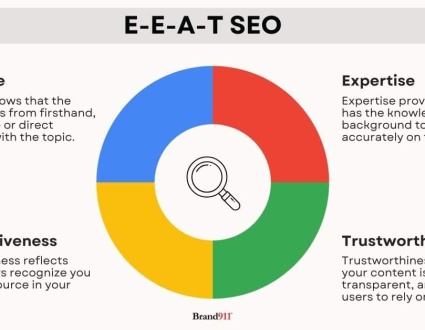
AI Overviews are changing how Google displays search results.
They appear above traditional rankings and pull insights from multiple websites, reshaping who gets seen and who gets skipped.
If your content doesn’t show up in these summaries, you’re already falling behind.
Thankfully, you can optimize for AI Overviews without starting from scratch.
This 30-day plan walks you through how to…
- Identify pages with ranking potential
- Rewrite and reformat your content for AI
- Build trust with credible sources and expert signals
- Monitor results and stay visible long-term
…and is part of a bigger strategy to improve your search visibility.
Let’s break down what AI Overviews are, why they matter, and how to start ranking fast.
Quick Summary: How to Rank in AI Overviews
- Create clear, helpful content that answers user questions up front
- Target long-tail, informational queries (5+ words)
- Use structured data like FAQ and HowTo schema
- Add expert bios and authoritative citations to boost trust
- Format for skimmability—use lists, subheadings, short paragraphs
- Update content regularly to stay relevant and competitive
- Track AI Overview appearances and monitor content performance
What Are AI Overviews?
AI Overviews are Google’s AI-generated summaries that appear at the top of search results. Instead of showing a single website snippet, they pull insights from multiple trusted sources to create a complete answer, often without the user needing to click through.
Why They Matter
Google’s new AI Overviews (also known as SGE results) sit prominently at the top of the search page, offering users an instant summary and giving cited websites prime exposure.
Pages featured in an AI Overview benefit from this first-position placement with significantly higher click-through rates.
Right now, AI Overviews appear in only about 1.28% of U.S. Google search results, but that share is quickly growing as the feature rolls out more widely (one analysis noted a ~156% surge in AI Overview frequency from late 2024 to early 2025).
This low initial prevalence means a big opportunity for early adopters. Forward-thinking SEOs can capture extra visibility by becoming one of the few sources highlighted in these AI-driven summaries.
Traditional SEO rankings still heavily influence whether you get featured in an AI Overview. Studies show 52% of sources cited by Google’s AI Overviews are pages already ranking in the top 10 organic results. In other words, strong rankings give you an edge–but importantly, nearly half of AI-cited sources come from beyond page one.
This indicates that high-quality, relevant content can be selected even if it’s not #1. Google’s AI is choosing sources based on credibility and relevance to the query, so content formatting, clarity, and authority signals now play a larger role in getting picked.
For example, experts recommend answering the user’s question directly in your opening lines and using a concise, authoritative tone, while structuring your content with clear headings or bullet points for easy parsing.
By doubling down on SEO best practices and delivering well-structured, trustworthy content, you improve your chances of being cited in AI Overviews, which can significantly boost your search visibility as this new feature continues to expand.
How to Rank in AI Overviews in 30 Days: Your Action Plan
You don’t need to guess what works. We’ve broken down exactly what to do week by week to give your content the best shot at showing up in AI Overviews.
This 30-day plan focuses on real actions:
- Auditing what you already have
- Optimizing your content and structure
- Building trust signals
- And staying visible long after the month is over
Let’s get into it.
Week 1: Find What’s Already Working
Before you start rewriting or restructuring anything, figure out what content already has potential.
Audit Your Existing Content
- Look for pages that rank in the top 10 for any keyword. These have the highest chance of being pulled into AI Overviews.
- Focus on informational content: blog posts, FAQs, how-to guides, and explainer pages.
Set Up Tracking Tools
- Use Google Search Console to monitor impressions and track content performance.
- Tools like Semrush’s AI Overviews Report or Advanced Web Ranking can help track AI Overview appearances.
Identify Long-Tail Opportunities
- Use tools like AnswerThePublic, AlsoAsked, or Google’s “People Also Ask” to find common questions in your niche.
- Prioritize queries with 5+ words and informational intent (“how to,” “what is,” “best way to…”). These queries often overlap with voice queries too—so optimize for voice search at the same time.
Tip: AI Overviews often appear for specific, niche questions, not broad keywords. The more precise your query targeting, the better your chances.
Week 2: Rewrite & Reformat for AI
AI Overviews favor content that’s direct, well-structured, and easy to scan. This week is about making your content readable for both people and algorithms.
If you need to go back to blogging basics, here’s how to write SEO-friendly blog posts that also perform in traditional search.
Answer the Main Question Up Front
- Lead with a clear, concise answer in the first 100 words.
- Use natural language that directly matches how people search.
- Example: If the query is “how to boost search rankings,” your opening should include a phrase like “To boost search rankings, start by…”
Format for Scannability
Break up content with:
- Bullet points for key takeaways
- Numbered lists for step-by-step processes
- Subheadings that match user queries
- Short paragraphs (1–3 sentences max)
Bonus: 78% of AI Overviews include lists. Use that to your advantage.
Add Structured Data
- Use FAQ schema for Q&A content.
- Use HowTo schema for instructional content.
- Use tools like Schema Markup Generator by Merkle or Google’s Rich Results Test to check your implementation.
Week 3: Prove Your Authority
Google’s AI looks for trustworthy sources, and that means your content needs to show real expertise.
Create Detailed Author Bios
Add bios that include:
- Full name and roll
- Relevant credentials or certifications
- Links to other published content
- Social media or professional profiles
This helps Google connect your content to a real, credible person, which is an important part of E-E-A-T (Experience, Expertise, Authoritativeness, Trustworthiness).
Want to take it further? Here’s how to build high-quality backlinks that support your authority.
Cite Trusted Sources
Use links from:
- .gov and .edu domains
- Reputable health, finance, or industry organizations
- Recent peer-reviewed studies or research reports
Link sources inline, not just at the bottom. AI prioritizes context-rich citations. Example: “According to the CDC…” is better than a generic list of sources.
Use Internal Links to Build Depth
- Connect related blog posts or service pages
- Add internal links to define concepts or expand on subtopics
- This shows you’re covering the topic thoroughly, and it keeps readers (and bots) on your site longer
Week 4: Stay Fresh + Measure
Getting into an AI Overview is one win, but staying there is the real challenge. This week is about keeping your content current and monitoring results.
Refresh Key Content
- Update stats, examples, and sources every 6–12 months
- Rewrite outdated sections with new information or angles
- Change the publish date and resubmit through Google Search Console
Fresh content signals relevance and improves your odds of being re-selected by Google’s AI.
Track AI Overview Appearances
- Use tools like Semrush’s AI Overviews Report or Advanced Web Ranking
- Take screenshots when your content is cited
- Watch for impressions without clicks. This is a strong sign your content is showing in AI Overviews
Monitor Zero-Click Performance
- Track branded search volume and brand mentions
- Use compelling meta descriptions to attract clicks when possible
- Consider adding lead magnets or email opt-ins to turn visibility into conversions
AI Overviews won’t always drive clicks, but they boost trust, visibility, and brand recognition. Make it count.
For long-term impact, you’ll also want to protect your online brand beyond just SEO.
Bonus: What to Avoid
Avoid these common mistakes that can kill your chances of ranking in AI Overviews:
- Don’t keyword-stuff your intro—focus on answering the question clearly
- Don’t write walls of text—use short paragraphs and clear formatting
- Don’t ignore mobile formatting—AI crawls mobile-first
- Don’t skip page speed—slow sites get filtered out
- Don’t rely on outdated content—freshness matters more than ever
If it’s hard to read or out of date, Google’s AI won’t use it.

Final Thoughts: Get Ahead While It’s Still Early
Ranking in AI Overviews isn’t about gaming the system. It’s about creating clear, credible, helpful content that answers real questions.
And right now, most businesses aren’t doing that.
You have a short window to get ahead while AI Overviews are still rolling out. Use this 30-day plan to position your brand as a go-to source Google’s AI can trust.
Key Takeaways
- Answer the main question in the first 100 words
- Use lists, short paragraphs, and schema markup
- Build trust with expert bios and credible citations
- Target long-tail, informational queries
- Keep content updated and monitor AI Overview appearances
Want help optimizing your content for AI-driven search? Explore our SEO and content optimization services.
The future of search is already here. Don’t get buried. Start showing up where it counts.
About us and this blog
We are a digital marketing company with a focus on helping our customers achieve great results across several key areas.
Request a free quote
We offer professional SEO services that help websites increase their organic search score drastically in order to compete for the highest rankings even when it comes to highly competitive keywords.
Subscribe to our newsletter!
More from our blog
See all postsRecent Posts
- How to Do a Content Gap Analysis December 30, 2025
- How to Distribute a Press Release (Without Wasting Time or Money) December 23, 2025
- What Is SEO Content? A Comprehensive Guide December 18, 2025













Recent Comments